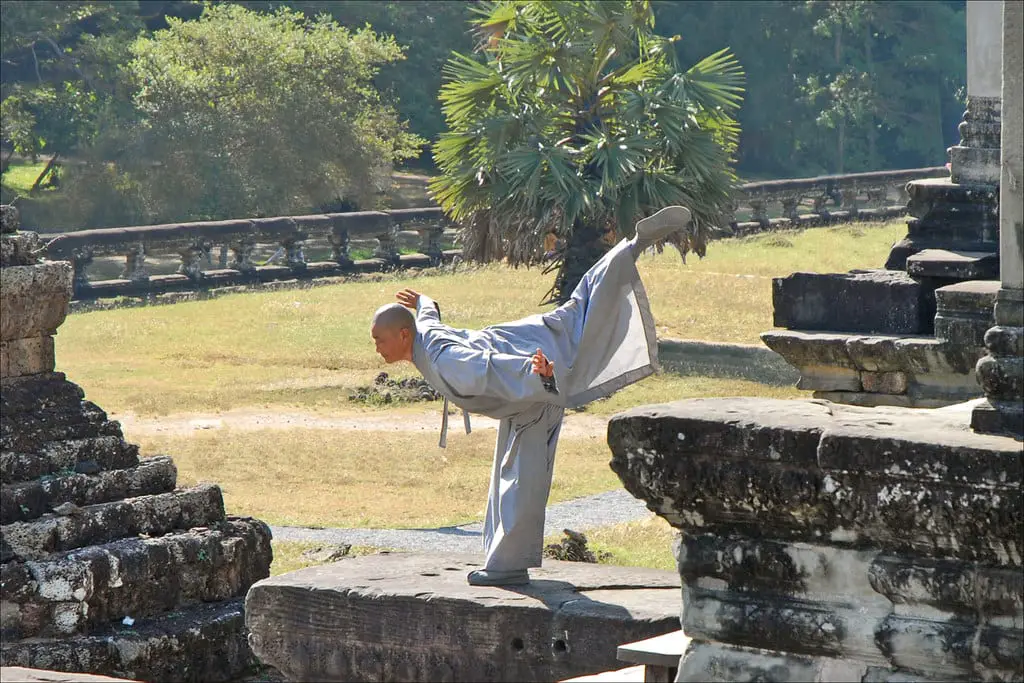As the great poet Tim Wheeler, of the band Ash, once wrote;
Kung Fu, do what you do to me.
It is a mantra that I have lived my life by, way before I’d ever heard of the group themselves, and sums up in eight words what I’ve felt about this genre ever since I saw Jackie Chan kicking ass on late-night Channel 4. The movie was Wheels On Meals and I’d only just hit my teens, but it started a love affair with Martial Arts that has lasted 35 years to date and still shows no signs of abating.
Across the last three and a half decades I have consumed every single morsel I have found on the subject. From books to documentaries and film after film, I have had an insatiable desire for all things chop-socky, much to the chagrin of my long-suffering friends and family who have been forced to sit through some utter garbage in my quest for Kung Fu nirvana. I just can’t help myself. I need the bargain section of eBay to feed the ninja monkey who lives on my back, but all is not lost.
What could be seen as a very pointless exercise in ‘How To Waste Your Life’ is, hopefully, about to pay dividends as the lovely people at 25YL Film have agreed to allow me to bring to you a ‘History Of Kung Fu Movies.’ The title should tell you everything you need to know about these articles and though I’m no Ric Meyers, I’d like to think I’ve accumulated enough knowledge on the subject that I can do it justice.
Guess there’s only one way to find out, huh?

It is impossible to start any study of Martial Arts movies without having Chinese opera as the jumping-off point After all, if it wasn’t for this art form then the whole genre of Kung Fu wouldn’t exist today. The earliest iteration of which was called Canjun Opera and was a simple two-man play where one character would take the role of a corrupt official and the other the role of a jester whose sole purpose was to mock and embarrass his counter-part. This was done in part as entertainment but also to remind everyone in the employ of the Later Zhao Dynasty that theft and bribery were frowned upon, though the reality was that if you were caught dipping your hand into the coffers then being ridiculed would be the least of worries.
As the centuries progressed, this simple premise would be refined to encompass everything from comedy to drama and all points in between and would be used as a way to sing the praises of victorious battles for whatever dynasty was in charge. Think Shakespeare but with a sh*t load more swords. The fighting style that was developed during this time by schools such as the Pear Garden would become hugely influential in shaping the way companies approached filming when Kung Fu became the latest hot ticket at the cinemas. It was a balletic way of battle—a free-flowing dance that would see the combatants perform spins and flips as they fought each other. It put the emphasis on spectacle more than it did actual Martial Arts prowess, but it would be adopted as the way forward when it made the transition from stage to screen.
But it wouldn’t just be Chinese opera that would have a heavy influence on Martial Arts movies over the years. Wuxia novels would leave an indelible mark on the genre as well.

Wuxia is a form of storytelling that dates back 2,000 years and focuses on the exploits of martial artists across Chinese history. In fact, martial artist is the literal translation of the word and the tales Wuxia tell are romanticized versions of old folklore, usually revolving around a lone protagonist (either male or female) making a stand against the corruption they see all around them. Robbing the rich and giving to the poor. Fighting against evil local government for the betterment of the people. These were heroes that the downtrodden could easily get behind so when celluloid became a viable way to bring entertainment to the masses, it was these novels that were adapted for the silver screen.
The first of these was The Burning Of The Red Lotus Monastery (Huo shao hong lian si ). Released in 1928 there are, sadly, no copies of this movie left—at least none that I’ve ever been able to find—but by all accounts, it was based on a newspaper serial called Strange Tales of the Adventurer in the Wild Country and was released in 18 parts with a running time of 27 hours. Now that’s something I’d quite happily binge watch. There is also no real explanations of what the plot revolved around either. This is something that happens a lot when a film is lost to time, but if the Shaw Brothers remake is anything to go by it could’ve been the yarn of a young man meeting his betrothed’s family, only to discover they might not be on the up and up and have the Red Lotus monastery in their sights for pillaging purposes. Then again, I’ve also read that it was about a young man saving his former commander from a Game of Death like scenario, while others have claimed it was all about a foul odor in the bottom of a pit.
Whatever the plot of this lost masterpiece is, it became so popular that the Wuxia genre of films and novels were banned between 1929-1933 as they were considered to go against the modern scientific society that was being cultivated and were accused of promoting backward thinking and superstition instead.
At the heart of the matter, Wuxia films have always lived in the realms of fantasy far more than they have reality. Modern day classics such as Crouching Tiger, Hidden Dragon rely more on magical swords, wire-work, and a China of the imagination than the work of, say Jackie Chan or Donnie Yen, which is firmly rooted in realistic fight scenes in modern-day settings and it was no different 100 years ago. It would be in Hong Kong where Kung Fu would be born as a backlash to the Wuxia style of cinema.
The Adventures of Fong Sai-Yuk was a two-part film released in 1938 that focused on the titular folk hero of the title and the adventures he found himself in. The problem here is that once again we have a film that no longer exists in any way shape or form, but it was impactful enough to be considered the first-ever Martial Arts movie to fall under the Kung Fu banner. It, and the films that followed, still adopted and adapted very familiar Wuxia tropes, especially when it came to their fight scenes, and the only real difference was that there were fewer magical elements to the stories being told.
It wouldn’t be until the 1948/1949 release of the Story of Huang Feihong that Kung Fu would get its own fighting technique. Directed by Wu Pang and starring Kwan Tak-hing, the Story of Huang Feihong is based on the real-life exploits of Wong Fei-hung, who was a master of Hung Ga. Again, very little remains of this movie, but this clip seems to recount the time that Fei-hung faced off against 30 or so gangsters. It also shows a more believable method of combat. It does have its faults (and they would be ones that stuck around until Jackie Chan went out of his way to change them, such as people standing off to the side, waiting for the hero to dispatch whoever he was facing before jumping in to have a go themselves), but it was a big enough shock to the senses that nearly every film company took it as their blueprint from there on out.
After this, the movies started to come thick and fast, with everyone wanting to make as much money as they could from this newfound craze, but it would remain localized to China and Hong Kong. This was due to the fact that there wasn’t any outlet for Asian cinema outside of its own borders. Nowhere else in the world was clamoring to see this product so the idea of exporting these films to America or the United Kingdom was a completely alien concept, but it wouldn’t stay alien for long. As we will see in the second part of my History Of Kung Fu, all it took was the intervention and business acumen of three brothers named Shaw to help set Kung Fu on its way to capturing the hearts and minds of fans around the globe.



Hi, this topic is truly fascinating. I used to write about the earliest kung fu movies, directed by people like Ren Pengnian and Hung Chung-ho (Sammo Hung’s grandfather), for the old Kung Fu Cinema site. If you’re interested in seeing some of the vintage memorabilia I found on eBay, check out my book at https://www.amazon.com/Electric-Shadows-Secret-History-Movies-ebook/dp/B00ELO8LNY